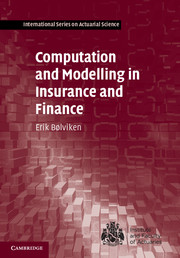Book contents
- Frontmatter
- Contents
- Preface
- 1 Introduction
- PART I TOOLS FOR RISK ANALYSIS
- PART II GENERAL INSURANCE
- PART III LIFE INSURANCE AND FINANCIAL RISK
- 12 Life and state-dependent insurance
- 13 Stochastic asset models
- 14 Financial derivatives
- 15 Integrating risk of different origin
- Appendix A Random variables: Principal tools
- Appendix B Linear algebra and stochastic vectors
- Appendix C Numerical algorithms: A third tool
- References
- Index
12 - Life and state-dependent insurance
from PART III - LIFE INSURANCE AND FINANCIAL RISK
Published online by Cambridge University Press: 05 May 2014
- Frontmatter
- Contents
- Preface
- 1 Introduction
- PART I TOOLS FOR RISK ANALYSIS
- PART II GENERAL INSURANCE
- PART III LIFE INSURANCE AND FINANCIAL RISK
- 12 Life and state-dependent insurance
- 13 Stochastic asset models
- 14 Financial derivatives
- 15 Integrating risk of different origin
- Appendix A Random variables: Principal tools
- Appendix B Linear algebra and stochastic vectors
- Appendix C Numerical algorithms: A third tool
- References
- Index
Summary
Introduction
Life and pension insurance are arrangements for which payment streams are determined by states occupied by individuals, for example active, retired, disabled and so on. These contracts typically last for a long time, up to half a century and more. A simple example is an arrangement where an account is first built up and then harvested after a certain date. At first glance this is only a savings account, but insurance can be put into it by including randomness due to how long people live. When such accounts are managed for many individuals simultaneously, it becomes possible to balance lifecycles against one another so that short lives (for which savings are not used up fully) partially finance long ones. There is much sense in this. In old age benefits do not stop after an agreed date, but may go on until the recipient dies.
Many versions and variants of such contracts exist. Benefits may be one-time settlements upon retirement or death of a policy holder or distribute over time as a succession of payments. Traditional schemes have often been defined benefit, where economic rights after retirement determine the contributions that sustain them. Defined contributions are the opposite. Now the pension follows from the earlier build-up of the account. Whatever the arrangement, the values created depend on investment policy and interest rate and also on inflation (which determines the real worth of the pension when it is put to use).
- Type
- Chapter
- Information
- Computation and Modelling in Insurance and Finance , pp. 433 - 477Publisher: Cambridge University PressPrint publication year: 2014

